What Is The Racial Makeup Of Santa Ana In Orange County
Santa Ana¶
Note
Cocky-Response Rates (SRR) DO NOT indicate the overall share of households or people counted in the census, just rather the share of housing units that filled out the form on their own.
City statistics such as population, race/ethnic demographic breakdown, and "hard-to-count" (HTC) characteristics are based on 2015-2019 ACS 5-year estimates and not the results of the 2020 Census.
See the Methodology section for information about how these numbers are calculated.
City Summary¶
The City of Santa Ana's last 2020 self-response rate (SRR) was 70.5%, which was college than its SRR in the 2010 census and lower than the SRR for Orange Canton (76.six%). The lowest self-responding tracts in the metropolis had a SRR in the l-56% range while the highest self-responding tracts had a SRR in the 85-100% range.
Of the lesser xx% everyman self-responding tracts in Orange Canton (116 tracts with an SRR beneath 71%), at that place were 26 census tracts that overlapped the Urban center of Santa Ana. Of those tracts, the largest share of the population was Hispanic/Latino of Whatever Race (86.two%) (by and large "Mexican" at 80.3%), followed by Asian (non-Hispanic) (half-dozen.viii%) (mostly "Vietnamese" at 3.v%). The most prominent hard-to-count (HTC) characteristics were households that were rented (65.9%), multi-unit structures (47.one%), people age 25 or older who are non high-school graduates (48.five%), people born exterior of the U.South. (45.8%), and people with an income beneath 150% of the poverty level (37.7%).
Of the top 20% highest self-responding tracts in Orangish County that overlapped the City of Santa Ana, the largest share of the population was Hispanic/Latino of Any Race (40.3%) (mostly "Mexican" at 39.0%), followed past Asian (non-Hispanic) (28.0%) (by and large "Vietnamese" at 22.9%). The virtually prominent HTC characteristics were people built-in exterior of the U.Due south. (40.i%) and people with an income below 150% of the poverty level (26.0%).
When looking at the Top and Bottom twenty% Analysis, it is also important to note if any race/ethnic groups and HTC characteristics are under or overrepresented compared to their estimated share of the city's population. For instance, the estimated Hispanic/Latino of Any Race population in Santa Ana is 76.8% simply Hispanic/Latino of Whatever Race makes upward 86.ii% of the lesser 20% lowest cocky-responding tracts overlapping the City of Santa Ana. See the assay, tables, graphs, and maps below for more details.
Note that in add-on to the county-wide Census Week of Action (July 27 to August 2) and Castilian Census Day of Action (September 28), at that place was a Census Caravan result in Santa Ana on May 29.
| City Population | City Population Size Rank (of 34 cities) |
|---|---|
| 332,794 | two |
| Urban center 2020 SRR | 2020 Metropolis SRR Rank (of 34 cities) |
|---|---|
| seventy.five% | 31 |
| Urban center 2010 SRR | 2010 City SRR Rank (of 34 cities) |
|---|---|
| 67.6% | 31 |
Boosted data resources:
Census QuickFacts (source: U.S. Census Bureau)
Hard to Count fact sheets (source: California Complete Count - Census 2020 Function)
Census Reporter (source: Census Reporter, NFP, an Illinois not-for-profit corporation)
Race/Ethnic Demographic Breakdown¶
The following table shows the race/indigenous demographic distribution and final 2020 cocky-response rates (SRR) in the city, compared to Orange County. The listed SRR for race/ethnic groups refers to the calculated SRR for all demography tracts where the grouping'southward estimated share of the population is greater than or equal to the estimated share of the population for the total geography (e.m. the city or county). It does non demonstrate the SRR of the whole group.
CORRECT INTERPRETATION: The calculated cocky-response charge per unit in Orangish Canton demography tracts where the estimated Asian (non-Hispanic) population made up at least 20.iii% of the population was 77.1%.
INCORRECT Estimation: The Asian (non-Hispanic) population had a self-response rate of 77.1% in Orange County.
Race/Ethnic demographic distribution and concluding calculated 2020 cocky-response rate in the metropolis, compared to Orange County:
| Race/Ethnic Group | % of City Population | % of County Population | # of Demography Tracts where % Population ≥ % Population in Urban center | # of Demography Tracts where % Population ≥ % Population in County | Final City SRR | Final County SRR |
|---|---|---|---|---|---|---|
| AMERICAN INDIAN / ALASKA NATIVE | 0.1% | 0.ii% | 19 | 160 | 72.iv% | 77.one% |
| ASIAN* | 11.half dozen% | 20.3% | 21 | 191 | 74.1% | 77.one% |
| Asian Indian | 0.two% | 1.8% | 16 | 168 | lxx.7% | 78.0% |
| Chinese | 0.ix% | 3.viii% | 25 | 160 | 72.7% | 78.six% |
| Filipino | 0.9% | 2.vi% | 28 | 199 | 72.3% | 77.iv% |
| Japanese | 0.3% | 1.ane% | 19 | 218 | 74.iv% | 80.2% |
| Korean | 0.two% | 3.0% | 21 | 132 | 72.ane% | 78.0% |
| Vietnamese | 8.0% | half dozen.six% | 19 | 122 | 75.7% | 77.five% |
| Other Asian | 1.3% | 1.7% | 21 | 205 | 71.8% | 77.half dozen% |
| Blackness / AFRICAN AMERICAN | i.0% | 1.6% | 21 | 212 | seventy.5% | 75.6% |
| HISPANIC / LATINO OF ANY RACE | 76.8% | 34.1% | 31 | 213 | 68.0% | 73.1% |
| Mexican | 71.ane% | 29.2% | 32 | 204 | 68.2% | 72.ix% |
| Puerto Rican | 0.2% | 0.3% | 22 | 168 | 71.8% | 77.3% |
| Cuban | 0.1% | 0.4% | sixteen | 202 | 71.7% | 75.6% |
| Other Hispanic/Latino | v.three% | 4.ii% | 25 | 236 | 70.3% | 76.1% |
| NATIVE HAWAIIAN / PACIFIC ISLANDER | 0.two% | 0.3% | 14 | 132 | 72.ii% | 76.ane% |
| SOME OTHER RACE | 0.2% | 0.two% | 11 | 157 | 72.6% | 77.six% |
| 2 OR MORE RACES | 0.8% | ii.8% | 24 | 251 | 73.0% | 78.7% |
| WHITE | 9.4% | twoscore.6% | 26 | 321 | 74.0% | 78.6% |
*The "ASIAN" race category does non include people of Hispanic/Latino origin, but the vii ethnic Asian subcategories (e.g., Korean, Other Asian) may include people of Hispanic/Latino origin.
"Hard-to-Count" (HTC) Characteristic Breakup¶
The following table shows the "hard-to-count" (HTC) characteristics and concluding 2020 self-response rates (SRR) in the city, compared to Orangish County. The SRR for a HTC characteristic refers to the calculated SRR in those census tracts where the characteristic's estimated percentage is greater than or equal to the estimated percentage for the full geography (due east.g. the city or canton). It does non demonstrate the SRR for specific types of households (i.eastward. that are rented) or populations (i.eastward. that are children under 5).
Right Interpretation: The calculated self-response rate for census tracts in Orange County where at least 42.half-dozen% of all occupied housing units were rented was 71.7%.
INCORRECT INTERPRETATION: Rented households had a self-response rate of 71.7% in Orangish County.
See the Methodology section for more data on Hard-to-Count demographics.
"Hard-to-count" (HTC) characteristics and last calculated 2020 self-response rates in the city, compared to Orange County:
| HTC Characteristic | % of Metropolis Population | % of County Population | # of Census Tracts where % Feature ≥ % Feature in City | # of Census Tracts where % Characteristic ≥ % Feature in County | Final Urban center SRR | Final Canton SRR |
|---|---|---|---|---|---|---|
| PERCENT OF Full HOUSING UNITS: | -- | -- | -- | -- | -- | -- |
| That are vacant | iii.0% | 5.seven% | 26 | 178 | seventy.8% | 72.6% |
| In a multi-unit structure with 3 or more units | 38.6% | 32.7% | 23 | 249 | 67.five% | 72.4% |
| Per centum OF HOUSEHOLDS (OR OCCUPIED HOUSING UNITS): | -- | -- | -- | -- | -- | -- |
| That are rented | 53.ix% | 42.six% | 24 | 268 | 66.4% | 71.vii% |
| That are overcrowded (> i.five persons/room) | 12.seven% | iii.2% | 23 | 187 | 66.6% | 71.5% |
| Without broadband subscriptions | 16.7% | 9.three% | 25 | 255 | 66.nine% | 74.5% |
| With limited-English speaking ability | 17.7% | viii.7% | 29 | 231 | 68.eight% | 74.6% |
| That are not-family (eastward.g. housemates, unmarried partners) | 18.3% | 28.3% | 24 | 222 | 71.0% | 73.two% |
| Receiving public aid income | 4.1% | 1.9% | 23 | 229 | 69.6% | 75.1% |
| PERCENT OF THE POPULATION: | -- | -- | -- | -- | -- | -- |
| That are children nether five | 7.4% | 5.9% | 26 | 235 | 67.0% | 75.three% |
| That was born outside of the U.Due south. | 43.3% | 30.one% | 30 | 244 | 70.8% | 74.4% |
| Who moved to Orangish County in the past year | two.0% | 4.four% | 23 | 195 | 72.0% | 74.four% |
| With income below 150% of poverty level | 30.one% | 17.9% | 22 | 219 | 66.8% | 71.7% |
| Age 16 or older that are unemployed | 5.1% | 4.half dozen% | 29 | 261 | 71.0% | 74.9% |
| Age 25 or older who are not high-schoolhouse graduates | 40.iv% | fourteen.5% | 29 | 208 | 68.ii% | 73.vii% |
Urban center-wide Self-Response Rates Over Time¶
Weekly self-response rates and weekly change in self-response rates in the city betwixt March and October 2020:
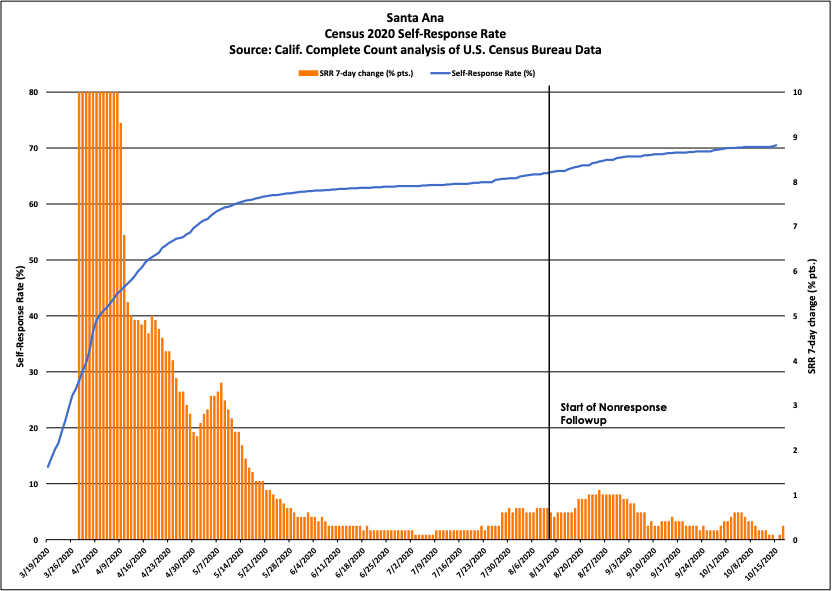
Self-Response Rates by Census Tract¶
The following map shows the concluding self-response rates (SRR) for every census tract that overlaps the city. Every bit shown in the legend to the left of the map, the census tracts in dark purple take the highest SRR, and the census tracts in night orange have the lowest SRR.
For more information virtually these demography tracts, visit this interactive map from the California Complete Count - Demography 2020 Office.
Map of final 2020 cocky-response rates for all census tracts that overlap the city:
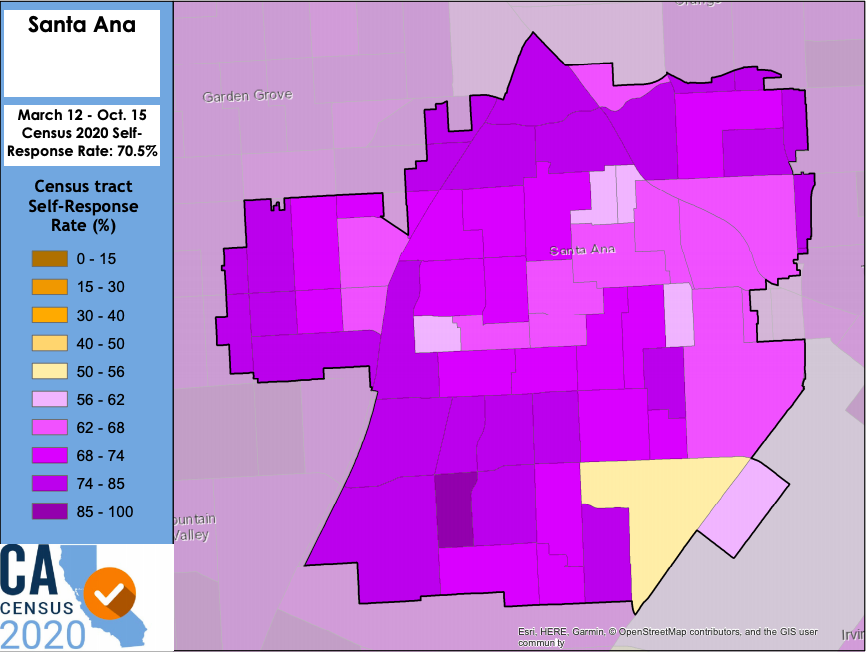
| Census tracts overlapping the city that are among the lowest self-responding tracts in Orangish County (below 71% SRR) |
|---|
| 06059074003, 06059074300, 06059074403, 06059074405, 06059074406, 06059074407, 06059074501, 06059074601, 06059074602, 06059074701, 06059074702, 06059074801, 06059074802, 06059074805, 06059074806, 06059074901, 06059074902, 06059075002, 06059075003, 06059075004, 06059075403, 06059075515, 06059076000, 06059089004, 06059089105, 06059099249 |
Bottom twenty% Analysis¶
The following table shows the race/ethnic and "hard-to-count" (HTC) characteristic make-up of the bottom 20% everyman responding demography tracts that overlap the city, compared to Orange Canton. Information technology does non demonstrate the self-response charge per unit (SRR) of the whole group.
Right Estimation: Of the bottom twenty% everyman responding census tracts in Orange County, 54.3% of the population was Hispanic/Latino.
INCORRECT INTERPRETATION: The self-response rate for the Hispanic/Latino population in Orange Canton was 54.3%.
Demographic brand-up of the bottom xx% lowest responding census tracts that overlap the city, compared to Orange County:
| Race/Ethnic Group | City | County |
|---|---|---|
| AMERICAN INDIAN / ALASKA NATIVE | 0.ane% | 0.2% |
| ASIAN* | half dozen.8% | 12.2% |
| Asian Indian | 0.two% | i.iii% |
| Chinese | 0.9% | 2.viii% |
| Filipino | 0.6% | 1.9% |
| Japanese | 0.1% | 0.5% |
| Korean | 0.2% | ane.five% |
| Vietnamese | 3.five% | 3.1% |
| Other Asian | 1.4% | ane.3% |
| BLACK / AFRICAN AMERICAN | 0.vii% | 1.8% |
| HISPANIC / LATINO OF ANY RACE | 86.2% | 54.3% |
| Mexican | 80.3% | 49.one% |
| Puerto Rican | 0.2% | 0.4% |
| Cuban | 0.1% | 0.3% |
| Other Hispanic/Latino | 5.7% | iv.6% |
| NATIVE HAWAIIAN / PACIFIC ISLANDER | 0.2% | 0.3% |
| Some other RACE | 0.1% | 0.2% |
| TWO OR More than RACES | 0.5% | 1.nine% |
| WHITE | five.four% | 29.one% |
*The "ASIAN" race category does not include people of Hispanic/Latino origin, but the vii ethnic Asian subcategories (eg, Korean, Other Asian) may include people of Hispanic/Latino origin.
| HTC Characteristic | Urban center | County |
|---|---|---|
| PERCENT OF Total HOUSING UNITS: | -- | -- |
| That are vacant | 3.7% | x.5% |
| In a multi-unit of measurement structure with 3 or more than units | 47.1% | 52.3% |
| PERCENT OF HOUSEHOLDS (OR OCCUPIED HOUSING UNITS): | -- | -- |
| That are rented | 65.ix% | 65.8% |
| That are overcrowded (> 1.5 persons/room) | 19.0% | seven.4% |
| Without broadband subscriptions | 20.5% | 12.vii% |
| With express-English language speaking ability | 22.1% | 10.eight% |
| That are non-family (e.chiliad. housemates, unmarried partners) | 17.6% | 35.4% |
| Receiving public aid income | v.1% | 2.five% |
| Pct OF THE POPULATION: | -- | -- |
| That are children under 5 | 8.one% | vi.6% |
| That was born outside of the U.S. | 45.8% | 34.4% |
| Who moved to Orange Canton in the by year | 1.2% | 5.five% |
| With income below 150% of poverty level | 37.7% | 29.4% |
| Age 16 or older that are unemployed | 5.three% | five.two% |
| Historic period 25 or older who are not high-school graduates | 48.5% | 24.four% |
Top twenty% Assay¶
The following tabular array shows the race/ethnic and "hard-to-count" (HTC) characteristic brand-up of the top 20% highest responding census tracts that overlap the city, compared to Orange Canton. It does not demonstrate the self-response rate (SRR) of the whole group.
Right INTERPRETATION: Of the top 20% highest responding census tracts in Orange County, 58.5% of the population was White (non-Hispanic).
INCORRECT INTERPRETATION: The self-response rate for the White (non-Hispanic) population in Orange County was 58.v%.
Demographic make-up of the top 20% highest responding census tracts that overlap the urban center, compared to Orange County:
| Race/Indigenous Group | City | County |
|---|---|---|
| AMERICAN INDIAN / ALASKA NATIVE | 0.9% | 0.2% |
| ASIAN* | 28.0% | 19.6% |
| Asian Indian | 0.0% | 2.3% |
| Chinese | 1.nine% | 4.vi% |
| Filipino | 0.3% | two.4% |
| Japanese | 1.four% | 1.8% |
| Korean | 1.two% | two.viii% |
| Vietnamese | 22.9% | iv.i% |
| Other Asian | 0.9% | i.8% |
| Black / AFRICAN AMERICAN | 2.4% | 1.3% |
| HISPANIC / LATINO OF ANY RACE | 40.3% | sixteen.3% |
| Mexican | 39.0% | 12.1% |
| Puerto Rican | 0.1% | 0.4% |
| Cuban | 0.0% | 0.iii% |
| Other Hispanic/Latino | one.1% | 3.v% |
| NATIVE HAWAIIAN / PACIFIC ISLANDER | 0.0% | 0.2% |
| SOME OTHER RACE | 0.0% | 0.2% |
| Ii OR More than RACES | four.vi% | 3.vii% |
| WHITE | 23.9% | 58.five% |
*The "ASIAN" race category does non include people of Hispanic/Latino origin, but the 7 ethnic Asian subcategories (eg, Korean, Other Asian) may include people of Hispanic/Latino origin.
| HTC Characteristic | City | County |
|---|---|---|
| PERCENT OF Full HOUSING UNITS: | -- | -- |
| That are vacant | 0.0% | ii.8% |
| In a multi-unit of measurement structure with 3 or more units | 0.seven% | half-dozen.five% |
| PERCENT OF HOUSEHOLDS (OR OCCUPIED HOUSING UNITS): | -- | -- |
| That are rented | ten.7% | 16.1% |
| That are overcrowded (> 1.5 persons/room) | 1.7% | 0.4% |
| Without broadband subscriptions | 12.v% | half-dozen.ii% |
| With limited-English language speaking power | 6.5% | 4.3% |
| That are not-family (due east.g. housemates, unmarried partners) | x.9% | nineteen.0% |
| Receiving public assistance income | 2.seven% | 1.3% |
| Pct OF THE POPULATION: | -- | -- |
| That are children under v | iii.half-dozen% | 4.7% |
| That was born exterior of the U.Due south. | 40.1% | twenty.nine% |
| Who moved to Orange County in the past year | 0.iv% | 2.ix% |
| With income beneath 150% of poverty level | 26.0% | 7.8% |
| Historic period xvi or older that are unemployed | 2.half dozen% | 3.9% |
| Age 25 or older who are not loftier-schoolhouse graduates | 20.7% | five.2% |
SRR Analysis - Race/Ethnic Group¶
The following graphs show the progression of self-response rates (SRR) over time in the city, disaggregated by race/ethnic group. Each data signal represents the calculated SRR for all census tracts where the grouping's share of the population is greater than or equal to their share of the population for the total geography (eastward.yard. the city or canton). Information technology does non demonstrate the SRR of the whole grouping.
For a urban center-by-urban center analysis of SRR for race/ethnic groups, meet the Race/Ethnicity section.
June-Oct 2020 weekly self-response rates by race/ethnic group, compared to city and county trends:
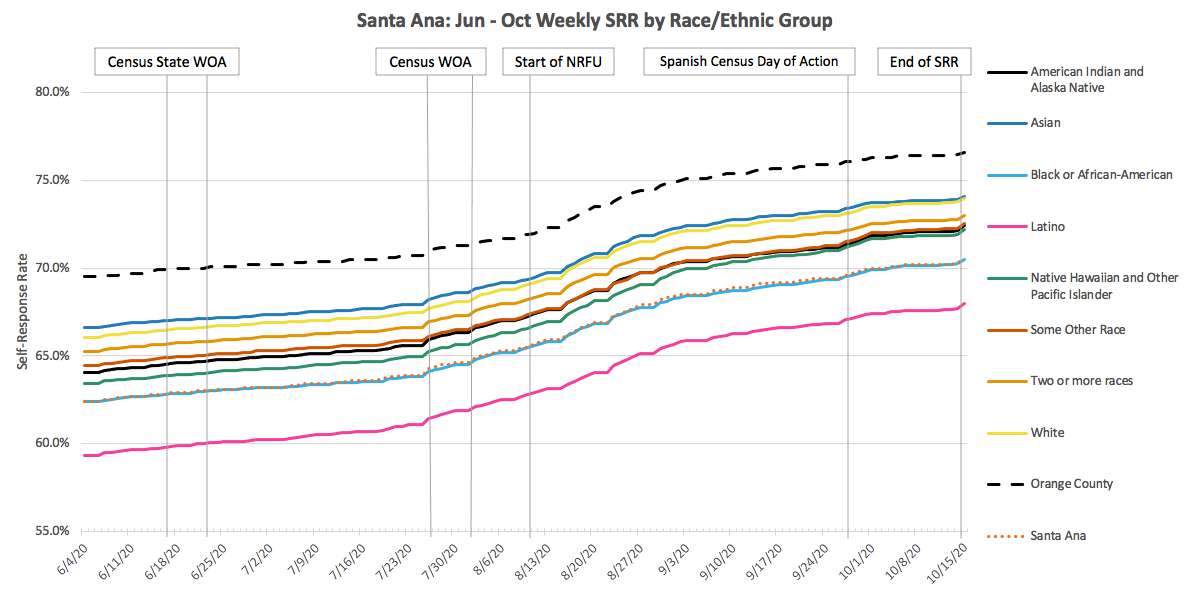
June-October 2020 weekly change in self-response rates by race/ethnic group, compared to city and county trends:

SRR Analysis - HTC Feature¶
The following graphs evidence the progression of self-response rates (SRR) over time in the city, disaggregated by select "difficult-to-count" (HTC) characteristics. Each data point represents the calculated SRR in those census tracts where the characteristic's estimated per centum is greater than or equal to the estimated percent for the full geography (east.g. the metropolis or county). Information technology does not demonstrate the SRR for specific types of households (i.e. that are rented) or populations (i.east. that are children nether five).
For a city-by-city analysis of SRR for select HTC demographics, come across the HTC Characteristic department.
June-Oct 2020 weekly cocky-response rates for select HTC characteristics, compared to urban center and county trends:
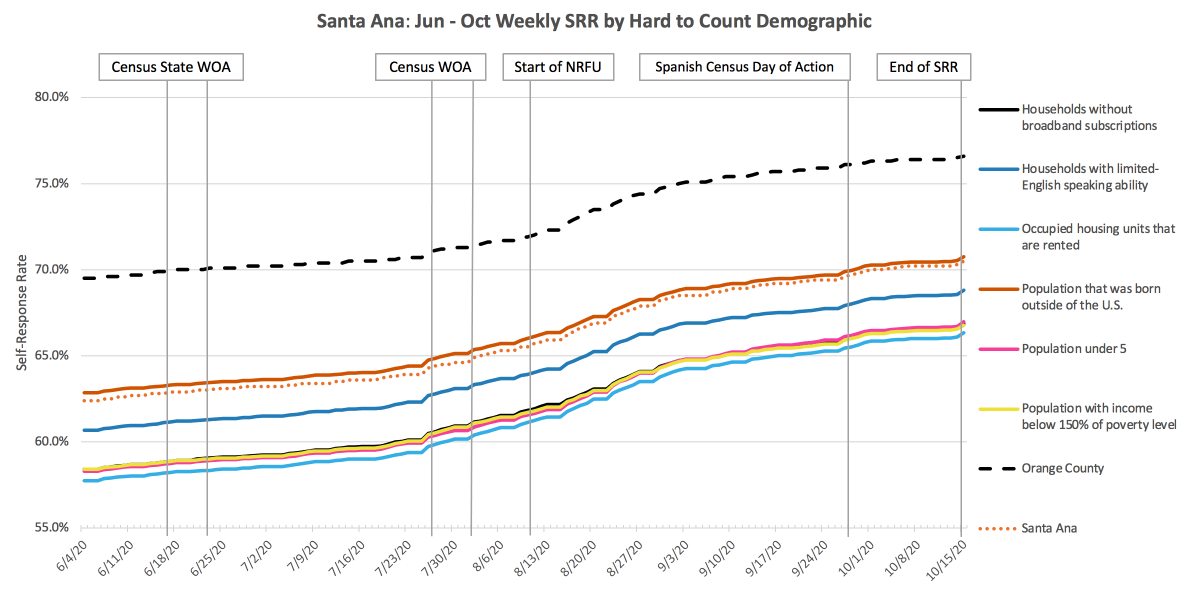
June-Oct 2020 weekly change in cocky-response rates for select HTC characteristics, compared to city and county trends:
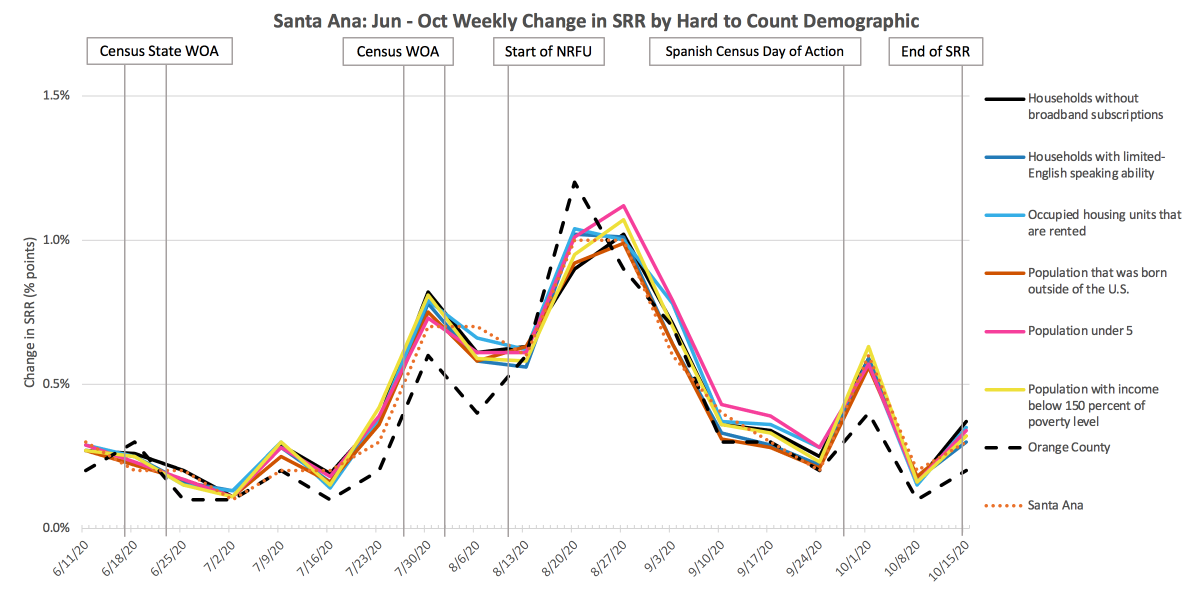
Source: https://occensusatlas.com/docs/cities/santa-ana.html
Posted by: dellingerknobson.blogspot.com

0 Response to "What Is The Racial Makeup Of Santa Ana In Orange County"
Post a Comment